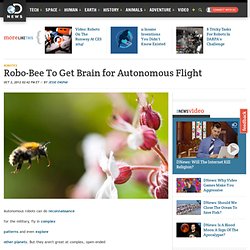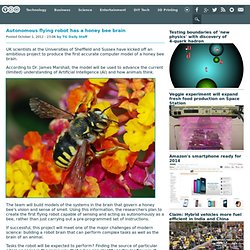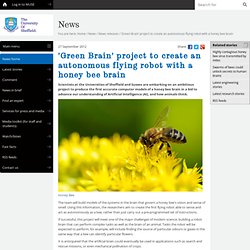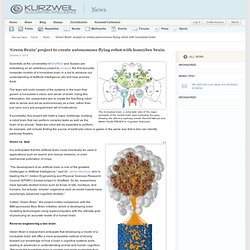

Green Brain Project Creates Autonomous Flying Robotic Honeybee. Put these three together and what do you get?

According to a research project called Green Brain, for starters you get the first comprehensive computer model of the brain of a honeybee. Then you get to use the model to create a brain for the first flying robot that can make its own decisions literally “on the fly,” responding to odors and other stimuli like a real honeybee. As for the Toulouse connection, those are no ordinary beekeepers — they form one of the world’s leading bee research teams at the Université de Toulouse, Centre de Recherches sur la Cognition Animale. The Green Brain and Computer Games The Green Brain moniker is meant to echo the Blue Brain human intelligence initiative, which is forging ahead on IBM’s Blue Gene supercomputer.
For Green Brain, a research team at the Universities of Sheffield and Sussex in England will use hardware from Texas-based NVIDIA Corporation, which specializes in accelerated processing for ultra high-performance supercomputers. Image: Honeybee. Robo-Bee To Get Brain for Autonomous Flight. Autonomous robots can do reconnaissance for the military, fly in complex patterns and even explore other planets.

But they aren't great at complex, open-ended. Bee brains help to make robots smarter. 2 October 2012Last updated at 06:45 ET Studying how bees sense the world could help robots become more autonomous Honey bee brains could soon be helping robots act more independently.

The way that bees smell and see is being studied in a £1m project to produce a simulation of the insect's sensory systems. The simulated bee brain will then be used by a flying robot to help it make decisions about how to navigate safely. Robots that emerge from the research project could help in search and rescue missions or work on farms mechanically pollinating crops. Autonomous flying robot has a honey bee brain. UK scientists at the Universities of Sheffield and Sussex have kicked off an ambitious project to produce the first accurate computer model of a honey bee brain.

According to Dr. James Marshall, the model will be used to advance the current (limited) understanding of Artificial Intelligence (AI) and how animals think. 'Green Brain' project to create an autonomous flying robot with a honey bee brain. ‘Green Brain’ project to create an autonomous flying robot with a honey bee brain - News releases - News. Scientists at the Universities of Sheffield and Sussex are embarking on an ambitious project to produce the first accurate computer models of a honey bee brain in a bid to advance our understanding of Artificial Intelligence (AI), and how animals think.

Honey Bee The team will build models of the systems in the brain that govern a honey bee's vision and sense of smell. Using this information, the researchers aim to create the first flying robot able to sense and act as autonomously as a bee, rather than just carry out a pre-programmed set of instructions. If successful, this project will meet one of the major challenges of modern science: building a robot brain that can perform complex tasks as well as the brain of an animal. Tasks the robot will be expected to perform, for example, will include finding the source of particular odours or gases in the same way that a bee can identify particular flowers. UK Scientists Developing Autonomous Flying Honey Bee Robots!
Honey Bee Photo via Shutterstock.

‘Green Brain’ project to create autonomous flying robot with honeybee brain. The honeybee brain: a schematic view of the major neuropils of the central brain area excluding the eyes, showing the olfactory pathway (credit: Randolf Menzel and Martin Giurfa/TRENDS in Cognitive Sciences) Scientists at the Universities of Sheffield and Sussex are embarking on an ambitious project to produce the first accurate computer models of a honeybee brain in a bid to advance our understanding of Artificial Intelligence (AI) and how animals think.

Honeybee artificial brain might help unravel animal cognition. A group of researchers at Universities of Sheffield and Sussex have embarked in a highly ambitious project, in a quest to accurately develop computer models of a honey bee brain.

Findings during actual development and testing itself might help answer some of the most puzzling questions in neuroscience, in a bid to understand how animal cognition works. The scientists intend on creating an artificial intelligence system for the honey bee, such that a flying autonomous robo-honey bee might sense the world around it, in terms of vision and smell, and act according to its external stimuli, just like the real insect would behave instead of just completing a series of pre-programmed tasks.
Tasks the robot will be expected to perform, for example, will include finding the source of particular odours or gases in the same way that a bee can identify particular flowers. “The development of an artificial brain is one of the greatest challenges in Artificial Intelligence. Source: www.shef.ac.uk. Home — Harvard School of Engineering and Applied Sciences.